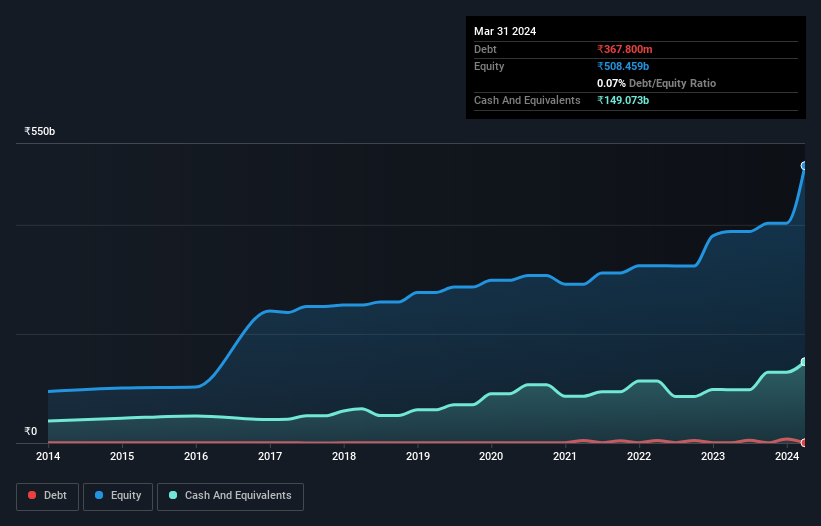- India
- /
- Basic Materials
- /
- NSEI:AMBUJACEM
Here's Why Ambuja Cements (NSE:AMBUJACEM) Can Manage Its Debt Responsibly

Warren Buffett famously said, 'Volatility is far from synonymous with risk.' When we think about how risky a company is, we always like to look at its use of debt, since debt overload can lead to ruin. We note that Ambuja Cements Limited (NSE:AMBUJACEM) does have debt on its balance sheet. But is this debt a concern to shareholders?
What Risk Does Debt Bring?
Debt and other liabilities become risky for a business when it cannot easily fulfill those obligations, either with free cash flow or by raising capital at an attractive price. Ultimately, if the company can't fulfill its legal obligations to repay debt, shareholders could walk away with nothing. However, a more usual (but still expensive) situation is where a company must dilute shareholders at a cheap share price simply to get debt under control. Of course, plenty of companies use debt to fund growth, without any negative consequences. When we think about a company's use of debt, we first look at cash and debt together.
View our latest analysis for Ambuja Cements
How Much Debt Does Ambuja Cements Carry?
You can click the graphic below for the historical numbers, but it shows that Ambuja Cements had ₹367.8m of debt in March 2024, down from ₹477.1m, one year before. However, its balance sheet shows it holds ₹149.1b in cash, so it actually has ₹148.7b net cash.

How Healthy Is Ambuja Cements' Balance Sheet?
According to the last reported balance sheet, Ambuja Cements had liabilities of ₹121.3b due within 12 months, and liabilities of ₹23.2b due beyond 12 months. Offsetting this, it had ₹149.1b in cash and ₹27.4b in receivables that were due within 12 months. So it actually has ₹31.9b more liquid assets than total liabilities.
Having regard to Ambuja Cements' size, it seems that its liquid assets are well balanced with its total liabilities. So it's very unlikely that the ₹1.69t company is short on cash, but still worth keeping an eye on the balance sheet. Simply put, the fact that Ambuja Cements has more cash than debt is arguably a good indication that it can manage its debt safely.
Even more impressive was the fact that Ambuja Cements grew its EBIT by 103% over twelve months. If maintained that growth will make the debt even more manageable in the years ahead. When analysing debt levels, the balance sheet is the obvious place to start. But it is future earnings, more than anything, that will determine Ambuja Cements's ability to maintain a healthy balance sheet going forward. So if you want to see what the professionals think, you might find this free report on analyst profit forecasts to be interesting.
Finally, while the tax-man may adore accounting profits, lenders only accept cold hard cash. Ambuja Cements may have net cash on the balance sheet, but it is still interesting to look at how well the business converts its earnings before interest and tax (EBIT) to free cash flow, because that will influence both its need for, and its capacity to manage debt. In the last three years, Ambuja Cements basically broke even on a free cash flow basis. While many companies do operate at break-even, we prefer see substantial free cash flow, especially if a it already has dead.
Summing Up
While we empathize with investors who find debt concerning, you should keep in mind that Ambuja Cements has net cash of ₹148.7b, as well as more liquid assets than liabilities. And we liked the look of last year's 103% year-on-year EBIT growth. So is Ambuja Cements's debt a risk? It doesn't seem so to us. There's no doubt that we learn most about debt from the balance sheet. But ultimately, every company can contain risks that exist outside of the balance sheet. For example, we've discovered 2 warning signs for Ambuja Cements that you should be aware of before investing here.
At the end of the day, it's often better to focus on companies that are free from net debt. You can access our special list of such companies (all with a track record of profit growth). It's free.
New: Manage All Your Stock Portfolios in One Place
We've created the ultimate portfolio companion for stock investors, and it's free.
• Connect an unlimited number of Portfolios and see your total in one currency
• Be alerted to new Warning Signs or Risks via email or mobile
• Track the Fair Value of your stocks
Have feedback on this article? Concerned about the content? Get in touch with us directly. Alternatively, email editorial-team (at) simplywallst.com.
This article by Simply Wall St is general in nature. We provide commentary based on historical data and analyst forecasts only using an unbiased methodology and our articles are not intended to be financial advice. It does not constitute a recommendation to buy or sell any stock, and does not take account of your objectives, or your financial situation. We aim to bring you long-term focused analysis driven by fundamental data. Note that our analysis may not factor in the latest price-sensitive company announcements or qualitative material. Simply Wall St has no position in any stocks mentioned.
Have feedback on this article? Concerned about the content? Get in touch with us directly. Alternatively, email editorial-team@simplywallst.com
About NSEI:AMBUJACEM
Ambuja Cements
Manufactures and markets cement and cement related products to individual homebuilders, masons and contractors, and architects and engineers in India.
Flawless balance sheet with proven track record.
Similar Companies
Market Insights
Community Narratives



